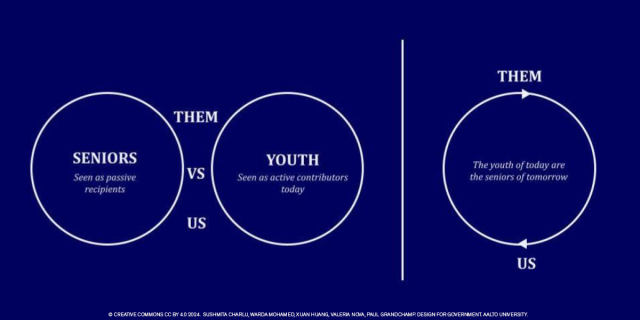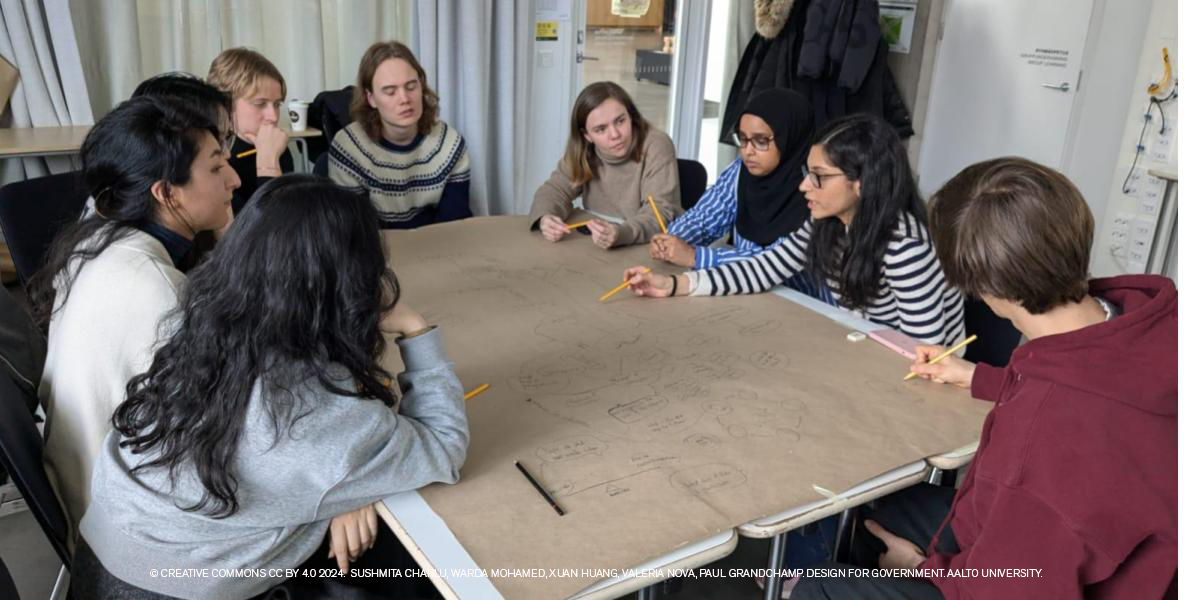This blog post reports on work-in-progress within the DfG course! The post is written by the inter-workstream group, 1B focused on the Ministry of Finance’s brief on ‘Open Governance’. The group includes Paul Grandchamp from Creative Sustainability program (Aalto ARTS), Valeria Nova from Creative Sustainability program (Aalto ARTS), Warda Mohamed from Collaborative and Industrial Design and Xuan Huang from Environmental Design and Creative Sustainability (Aalto ARTS).
Written by: Sushmita Charlu
We left an engaging roundtable with Katju Holkeri and Ira Alanko from the Ministry of Finance, and Auni-Marja Vilavaara, the Chair of the Elderly Citizens Council in Helsinki feeling simultaneously excited and overwhelmed. In the previous weeks, our group members had worked within specific workstreams, namely, Aging Population and Public Services, Open Governance, Elderly Participation Initiatives and Elderly inclusion in the Action Plan. Now it was time to bring the workstreams together to unpack Open Government in Finland using systems thinking lenses to reframe what we had understood so far.
Mapping Stakeholder Priorities
Sitting down together as the entire Open Government Supergroup, we used system mapping to observe both the interconnectedness between the various levels that each of the workstreams had focused on — the local, regional, national and international levels — as well as certain disconnects between these levels.
Through our workstream research, we had learned that senior citizens — already highly engaged in political participation — wished to play a more active role in shaping what affects them, particularly in areas like health services (Nygård & Jakobsson, 2013).
While much of the reports and resources we found framed Finland’s aging population as a demographic and economic crisis, a few of them, such as the Aging Studio by Helsinki Design Lab (2010) also highlighted the untapped opportunities of the phenomenon of aging in Finland. I was most surprised to learn people not only develop better maturity with age, but also become more creative (Weir, 2023). Why do we then, as a society, dismiss this immense potential and view them as beneficiaries of special services, and not as experienced contributors to our collective future?
Open Government in Finland, with its goal of addressing the needs of an aging population, is no doubt an ambitious initiative. However, our engagement with its representatives provided us with a much-needed reality check: without legislative authority, the responsibility for translating and implementing goals and action plans fell to municipal-level civil servants.
This reality underscores Open Government’s primarily strategic role, guiding its priorities toward building trust in the government, making diverse voices heard, and inspiring catalysts, be it individuals, civil society organizations or civil servants at the municipal level, to activate engagement at the community level.
As Katju Holkeri (Project Partner, Ministry of Finance) put it “It is about the moment of participation (in initiatives such as National Dialogues) and the opportunity to feel seen and heard.”
Reframing Aging: An Opportunity for Intergenerational Collaboration
At first glance, it appeared difficult to reconcile the scope of Open Government’s work with the needs of an aging population. However, as our course instructor, Marco Steinberg pointed out, the way we frame the problem can shape our approach to how we solve it.
Over the course of our many discussions in the classroom, one reminder has come up constantly — we are all aging. Aging population is a dynamic phenomenon, and yet one that is a diverse experience. The ability to age with dignity, health, and security is strongly tied to the structural inequalities that accumulate over a lifetime. The youth of today are the seniors of tomorrow, and will no doubt face similar challenges. This was thus an opportunity to rethink who we assume decision-making is for—and what perspectives and tacit learnings are being left out without even realizing it.

Figure 1: A divisive narrative that segments age groups
“There are issues connecting the different generations, including accessibility, COVID, climate change & (infrastructure) planning.” — Auni-Marja Vilavaara, Chair, Elderly Citizens Council 2025.
Could intergenerational solidarity and representation be the key to building a more resilient society? Could cultivating this intergenerational culture expand our notion of diversity beyond traditional segmentation?
We talked about how we tend to have a limited view about the ways in which senior citizens participate in society and about their ability to make a difference. We mentally place them in a public dialogue, or on a park bench complaining about their experiences. The reframing process led to a delightful exercise where we thought of various participation methods (games, hackathons, action days) which were typically associated with younger people, and tried to imagine seniors in these scenarios. We realised that it wasn’t that absurd or even unfeasible.
The Age of Participation and Beyond
As we discovered during and after our Mid-term presentation to our Project Partners, we continue to be challenged by the act of balancing upstream with downstream level thinking. We were reminded (with a touch of skepticism) that while many of the opportunities we identified were exciting in concept, it was vital for us to consider the interface of civil servants going forward, as they would be the implementers of any kind of intervention.
Reflecting on the work we have done and the feedback we have received so far, I believe there are many promising avenues, which are easy to get lost in. However, building an intergenerational culture within existing Open Government initiatives seems to be a wholesome direction in itself. This approach is well aligned with the Ministry of Finance’s wishes to increase the diversity of participants and activate civil servants to carry out initiatives downstream. As we enter the field research phase, and continue the process of system analysis, we aim to identify the aspects and issues that unite different generations and drive civic engagement.
References
Nygård m, Jakobsson g. Senior citizens and political participation – evidence from a Finnish regional study. Ageing and Society. 2013;33(1):159-180. doi:10.1017/S0144686X11001139
Helsinki Design Lab (2010). Ageing Studio. https://www.helsinkidesignlab.org/dossiers/ageing/the-challenge_2
Weir, K. (2023). Ageism is one of the last socially acceptable prejudices. Psychologists are working to change that. Retrieved March 16, 2025, from Ageism is one of the last socially acceptable prejudices. Psychologists are working to change that
The DfG course runs for 14 weeks each spring – the 2025 course has now started and runs from 24th Feb to 27th May. It’s an advanced studio course in which students work in multidisciplinary teams to address project briefs commissioned by governmental ministries in Finland. The course proceeds through the spring as a series of teaching modules in which various research and design methods are applied to address the project briefs. Blog posts are written by student groups, in which they share news, experiences and insights from within the course activities and their project development. More information here about the DfG 2025 project briefs. Hold the date for the public finale on Tuesday 27th May!

